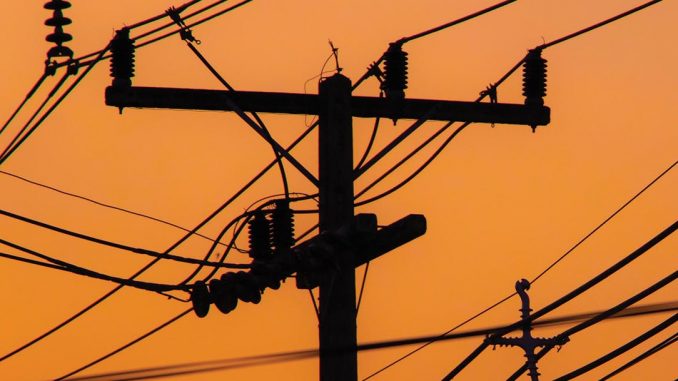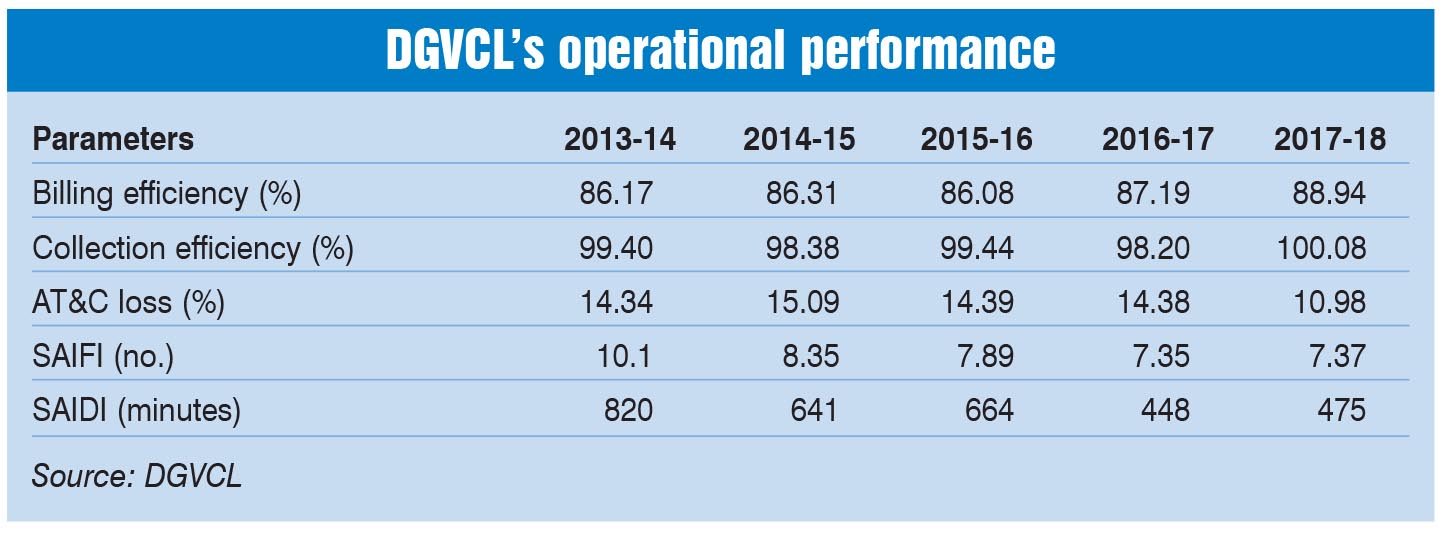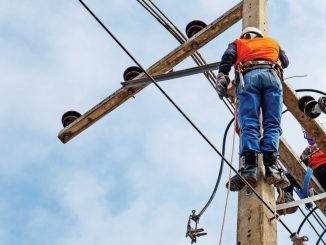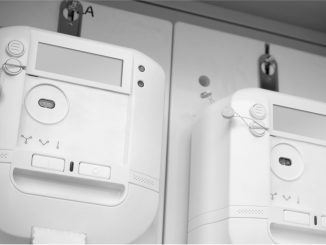
Dakshin Gujarat Vij Company Limited (DGVCL), one of the four state discoms in Gujarat, was incorporated in 2003 post the unbundling of the erstwhile Gujarat Electricity Board. It caters to around 3.11 million consumers in the state. DGVCL is among the best performing discoms in the country. Its aggregate technical and commercial (AT&C) losses stood at 10.98 per cent in 2017-18 as compared to a national loss level of 19 per cent. These have further reduced to 6.53 per cent, as per the latest data (as of December 2018) on the Ujwal Discom Assurance Yojana (UDAY) portal.
DGVCL has consistently secured A+ grade for its high operational and financial performance. The discom recently received the National Energy Conservation Award, 2018 (second prize) in the “Electricity Distribution Companies Sector” category for the efficient utilisation and conservation of energy as an industrial unit.
In recent years, the discom’s focus has been on high voltage distribution systems (HVDS), underground cabling, solar water pumping, and distribution infrastructure augmentation and modernisation, etc. The discom is looking to invest a capital expenditure of Rs 32.28 billion by 2022-23 towards network augmentation and system strengthening.
Consumer base and sales
DGVCL’s area of operations, covering 23,307 square km, is spread across seven districts of the South Gujarat region – Bharuch, Narmada, Surat (except part of Surat City), Tapi, Dangs, Navsari and Valsad. The company is headquartered at Surat and functions in four circles, 19 divisions and 131 sub-divisions.
DGVCL’s consumer mix includes a sizeable share of agricultural consumers. Of the 3.11 million consumers the discom caters to (as of March 2018), 2.49 million are domestic consumers, 0.40 million are industrial consumers and 0.16 million are agricultural consumers.
In terms of energy sold, industrial consumers accounted for over 81 per cent of the energy sales in 2017-18, followed by industrial consumers (13 per cent), agricultural consumers (5.26 per cent) and commercial consumers. DGVCL’s energy sales increased 8.78 per cent, from 18,147.88 MUs in 2016-17 to 19,741.44 MUs in 2017-18. The growth in consumer demand can be attributed to schemes such as the Sahaj Bijli Har Ghar Yojana (Saubhagya). Meanwhile, the average per unit cost of power procurement in 2017-18 was Rs 5.30.
Network growth
DGVCL’s distribution network stood at 106,642 ckt km as of March 2018. It comprises 52,440.81 ckt km of 33 kV lines, 51,968.85 ckt km of 11 kV lines and 2,232.73 ckt km of low tension (LT) lines. Over the past five years, the total distribution network line length has witnessed a CAGR of 5.64 per cent.
The discom currently has over 250 substations, of which 230 substations with 5,911 MVA of capacity are at the 11 kV level and 22 substations with 1,663 MVA capacity are at other voltage levels. The discom’s substations registered an increase of 5.5 per cent at the 11 kV level in 2017-18 over the previous year.
The discom has a total of 2,166 feeders in its network at the 33 kV and 11 kV levels, all of which have been metered. Further, the discom has achieved a 100 per cent metering level for distribution transformers. Also, all consumer categories have been fully metered, except for agricultural consumers where metering levels stood at 73.22 per cent as of March 2018.
Operational performance
Under the UDAY scheme, the discom’s AT&C losses have reduced from 15.09 per cent in 2014-15 to 10.98 per cent in 2017-18. Another strong area for the discom has been high collection efficiency, which reached 100.08 per cent in 2017-18. The billing efficiency stood at 88.94 per cent in 2017-18 as compared to 87.19 per cent in 2016-17.
In terms of performance of reliability indices, DGVCL’s SAIFI (System Average Interruption Frequency Index) stood at 7.37 in 2017-18, which was a significant improvement over 10.1 in 2013-14. Similarly, SAIDI (System Average Interruption Duration Index) stood at 475 minutes in 2017-18 as compared to 820 minutes in 2013-14. Further, the distribution transformer (DT) failure rate decreased from 10.12 per cent in 2013-14 to 6.52 per cent in 2017-18.
 Financial highlights
Financial highlights
In 2017-18, the discom’s total revenues stood at Rs 118.35 billion, a 4.54 per cent increase over the previous year. A profit-making utility, DGVCL registered net profits of Rs 944.70 million in 2017-18, 1.64 per cent higher than the net profit of Rs 929.40 million in 2016-17.
Its debt equity ratio stood at 0.02 in 2017-18, while return on equity and return on net worth stood at 24.88 per cent and 2.79 per cent, respectively. DGVCL received a subsidy of Rs 485.50 million in 2017-18 as compared to Rs 481.00 million in 2016-17. Meanwhile, the discom’s ACS-ARR gap stood at Re -0.11 per unit as of December 2018 as against Re -0.05 per unit in 2016-17.
Key interventions and initiatives
The discom is involved in all key central government schemes. Under the Restructured Accelerated Power Development and Reforms Programme component of the Integrated Power Development Scheme (IPDS), DGVCL has installed supervisory control and data acquisition/distribution management systems in Surat city at a project cost of Rs 949.1 million. The discom has also received a sanction of Rs 1.97 billion, of which Rs 1.87 billion will be used for system strengthening across four projects, and Rs 28.6 million for IT Phase II projects. The majority of these investments will be used for the installation of 17 new 66/11 kV substations (Rs 867 million) as well as for 282 km underground cabling works (Rs 423 million). So far, the discom has met targets for laying 117.95 km of underground cables along with 269.04 km of aerial bunched cables (ABC) and setting up six new substations with 210 MVA transformer capacity.
Under the Deendayal Upadhyaya Gram Jyoti Yojana, the discom has received Rs 1,860.4 million, of which Rs 881 million will be used for the installation of ABC cables and Rs 200.8 million for HVDS systems. In order to eliminate low voltage distribution, DGVCL is gradually shifting to HVDS by erecting small capacity transformers to meet the load requirements of individual consumers or very small consumer groups.
DGVCL along with other state discoms has initiated a pilot project, “Suryashakti Kisan Yojna”, for the solarisation of agriculture connections. The scheme is being implemented on 137 agricultural feeders covering 124,000 agricultural connections in 33 districts of Gujarat at a proposed investment of Rs 9 billion. As per the scheme, farmers with electricity connections will be given solar panels as per their load requirements. The state and central governments will give 60 per cent subsidy on the cost of the project. The farmers are required to bear 5 per cent cost, while 35 per cent will be provided to them as an affordable loan at interest rates of 4.5-6 per cent.
DGVCL is also implementing the solar water agriculture pumping scheme and the solar home light scheme (SHLS). All agriculture applications registered under other schemes can be brought under the solar water agriculture pumping scheme. In 2016-17, DGVCL commissioned a total of 1,600 solar agricultural pumps at an expenditure of Rs 688.9 million. SHLS involves the electrification of remote locations. During 2016-17, the discom installed 4,100 solar home lights in these areas at an expenditure of Rs 187.8 million.
Future plans
DVGCL expects to incur a capex of Rs 7.06 billion in 2018-19 and cumulatively Rs 32.28 billion by 2022-23. It also plans to add 3,495 MVA of transformer capacity, 30,010 ckt km of distribution line length to its network, and 84 new substations between 2018-19 and 2022-23.
 Conclusion
Conclusion
DGVCL has shown consistent improvement in its operational and financial performance. However, a key concern for the discom, as pointed out by the power ministry, is the low budgetary allocation as compared to the actual subsidy claims. These concerns notwithstanding, DGVCL is leveraging the gains from the UDAY scheme to drive future growth.



